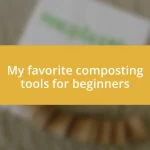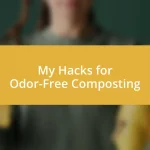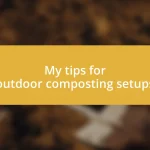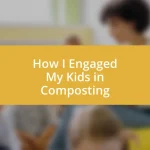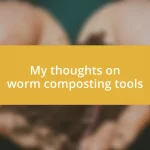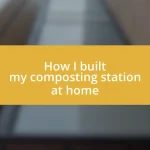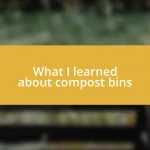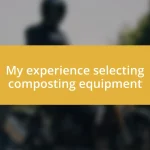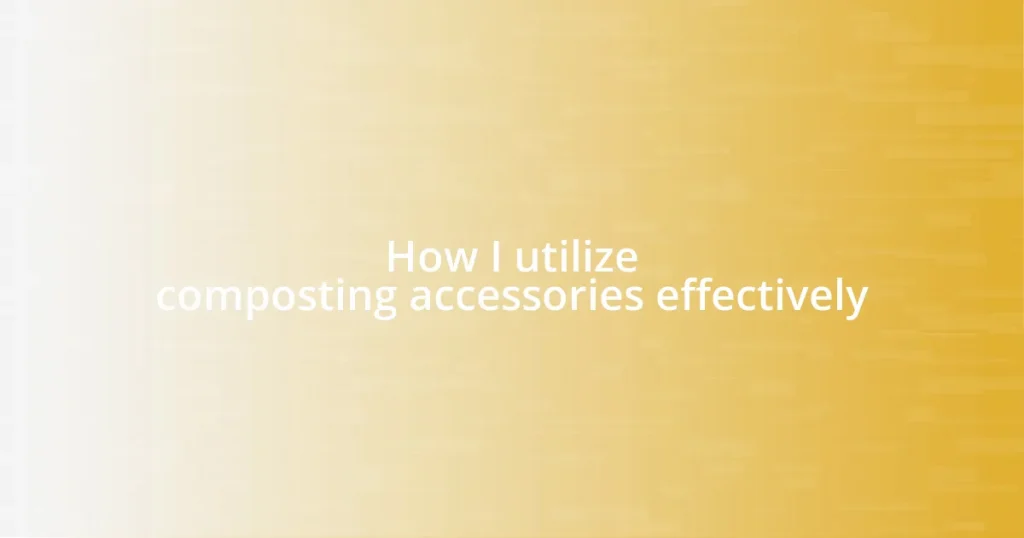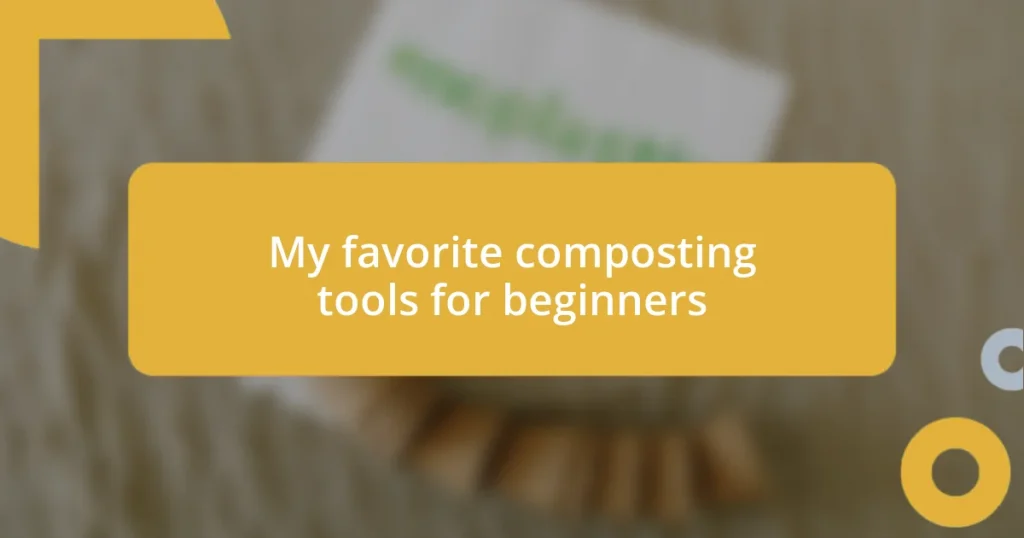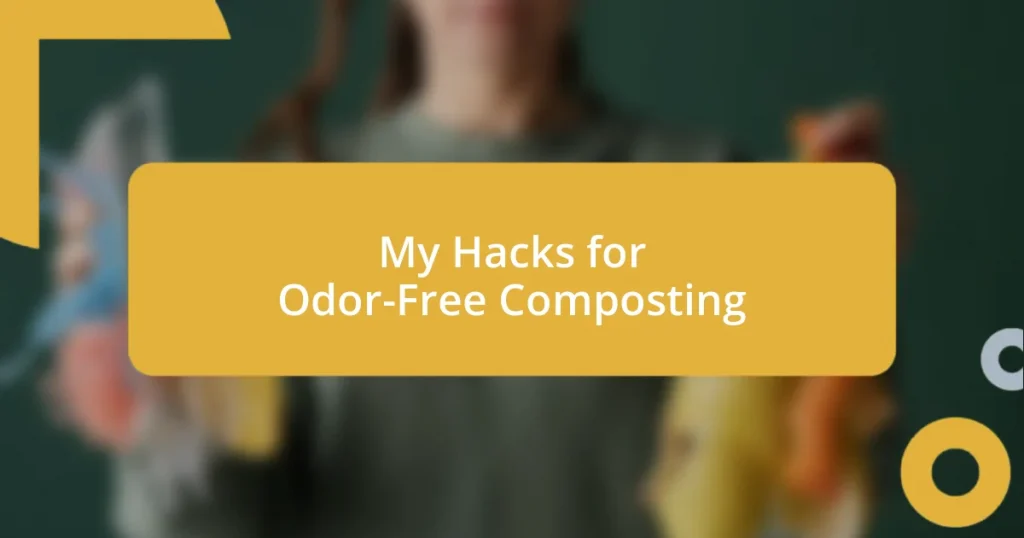Key takeaways:
- Composting enhances family bonding and teaches children about sustainability and responsibility through hands-on involvement and discussions about nature.
- Choosing the right composting method, such as a tumbler, can engage kids visually and create a fun, shared family project.
- Monitoring and using finished compost provides a tangible lesson on the impact of their actions, reinforcing the cycle of life and connection to nature.

Understanding the Benefits of Composting
When I first delved into composting, I was genuinely surprised by the variety of benefits it offers. Not only does composting reduce waste, but it also enriches the soil in my garden, creating a thriving ecosystem right in my backyard. Have you ever seen your plants bloom more vibrantly after sprinkling fresh compost? It’s like giving them a delicious meal, and trust me, they’ll thank you for it!
I vividly remember the first time I took my kids to our compost pile. Their eyes lit up as they discovered how kitchen scraps could transform into nutrient-rich soil. Watching them grasp the concept of recycling organic waste fueled my desire to engage them further. It made me realize that composting isn’t just an eco-friendly practice; it’s an opportunity to teach my children about sustainability and responsibility.
Embracing composting has not only helped our environment but has also fostered a sense of community and connection for my family. Whenever my kids help me sift through the compost, they ask questions about worms and microbes, sparking lively discussions about nature. Isn’t it fascinating how a simple practice can evolve into a bonding experience that cultivates curiosity? That’s a benefit I cherish deeply.

Choosing the Right Composting Method
Choosing the right composting method is crucial for maximizing engagement with your kids and ensuring successful composting. When I began this journey, I was overwhelmed by the options. From traditional piles to indoor worm bins, each method has its unique charm. I opted for a tumbler compost bin because it allowed my children to easily see the decomposition process in action. It became a magical science experiment for them, turning food scraps into something valuable right before their eyes.
I encourage you to consider your available space and family dynamics before making a choice. For instance, my neighbor swears by a backyard compost pile, while I found that an indoor method kept my kids involved year-round, regardless of seasonal changes. In my experience, the key is to choose a method that you can maintain together as a family, making it a shared endeavor rather than a chore.
Here’s a quick comparison of popular composting methods to help you decide:
| Method | Best For |
|---|---|
| Compost Pile | Large yards, families with outdoor space |
| Compost Bin | Moderate spaces, easy access for kids |
| Worm Bin | Apartment dwellers, indoor engagement |
| Tumbler | Quick mixing, visually engaging for kids |

Involving Kids in the Process
Involving kids in the composting process can be a delightful experience that nurtures their sense of responsibility and curiosity about the environment. Once my children understand the significance of composting, I encourage them to take hands-on roles. The first time we sorted through our scraps together, their enthusiasm was infectious. They loved being “bin inspectors,” identifying what could go in and what should stay out. It transformed composting into a family project, and I could see their pride as they contributed to our little ecosystem.
Here are some simple ways to get kids involved in composting:
- Scrap Sorting: Let them choose which food scraps go into the bin. It’s a fun scavenger hunt!
- Daily Duties: Assign them the responsibility of checking the compost regularly. This instills a sense of ownership.
- Worm Watch: If you’re using a worm bin, allow them to observe and learn about these amazing decomposers.
- Record Keeping: Encourage them to keep a daily or weekly log on how the compost is progressing.
- Creative Activities: Engage them in making signs or labels for the compost area to personalize their space.
This level of involvement not only fosters their environmental consciousness but also creates countless moments filled with laughter and learning as we nurture our compost together. Seeing their fascination with nature and the transformation of waste often brings a joyful warmth to our home.

Fun Composting Activities for Children
One of the most enjoyable activities that my kids look forward to is our weekly “Compost Ideas Day.” We gather in the kitchen and brainstorm all the food scraps from the week that can go into the compost. I remember the first time we did this; my son was giggling as he suggested old cereal because, in his words, “It’s already crumbly!” This simple exercise sparked their imaginations and turned a practical task into a fun family event, lighting their curiosity about what happens to our food waste.
Another engaging activity is to create compost art. My daughter loves to collect colorful leaves and bits of natural materials to decorate our compost area. It’s incredible how her art reflects her understanding of natural cycles; she once painted a large mural depicting worms at work! Not only does this personalize our composting space, but it also allows her to express herself while deepening her connection to the environment. Have you ever thought about how creative expressions can flourish through sustainability?
We also host “Compost Science Days,” where we dig into the science behind decomposition. I’ll never forget the look on my kids’ faces when we observed the temperature change inside our tumbler during the summer. They felt like little scientists conducting experiments! We even used a simple thermometer to check the heat. Sharing these discoveries brought us closer as a family, fostering a sense of wonder as they grasped the importance of our efforts. It’s such a beautiful reminder that composting is not just about waste; it’s about growth and learning together.

Teaching Kids About Organic Waste
When teaching kids about organic waste, I find that storytelling works wonders. One afternoon, while chopping veggies for dinner, my daughter noticed the scraps piling up. I casually explained how those scraps can turn into nutrient-rich soil. Her eyes widened with curiosity, and she immediately began asking questions like, “Does that mean our old lettuce can help grow new plants?” It was in that moment I realized how powerful the concept of recycling food could be for kids.
Engaging them with their own experiences makes the learning process so much richer. I often remind my kids of the time they planted seeds in the garden, explaining that compost is the magic behind the sprouting life. They seem to grasp the concept more when they connect it with what they see, taste, and touch. I even overheard them chatting among themselves about how they would convince their friends to compost, showcasing their growing sense of responsibility. Can you remember a time when you shared something you learned? It creates a strong bond and reinforces their understanding.
To keep things simple, I often find that visuals really help connect the dots for children. We made a fun chart together, illustrating the “Do’s and Don’ts” of composting. Pictures of what belongs in the bin versus what should go into the trash encouraged them to think critically about waste management. Using their drawings added an element of pride, and now the chart hangs prominently in our kitchen. Seeing their own artwork sparking discussions about composting? That’s both joyful and rewarding for all of us!

Maintaining Your Compost Together
Maintaining our compost together has become a cherished routine in our family. Every week, we take turns turning the pile, and watching my kids’ excitement as they discover all the little critters hard at work is truly heartwarming. I must say, there’s something magical about seeing them don their gloves, laughing as they dig through the rich, dark matter with genuine curiosity. Have you ever felt the thrill of watching children connect with nature in such a hands-on way?
I remember one day when my daughter found a few worms while turning the compost. Her shriek of delight was unforgettable! We paused our work, and she gently held up the worm like it was a rare treasure, asking, “Can we name it?” That small moment turned into an impromptu family discussion about the essential role worms play in creating healthy soil. It struck me how these simple acts of maintenance deepen their understanding and ignite their passion for the environment.
Involving my kids in regular maintenance taught them responsibility too. They take pride in checking moisture levels and adding water when necessary, and I’ve noticed how they’ve started to apply this care to other aspects of their lives. The other day, one of them asked if we could extend this idea to watering the garden, showing me they’re not only learning but also eager to expand their efforts. Isn’t it incredible how these small moments can ripple out into more mindful actions?

Monitoring and Using Finished Compost
As the compost pile starts to break down, I’ve learned to keep a close eye on its transformation. I distinctly remember the first time we took a peek at our finished compost—it was like unveiling a treasure! I asked the kids, “What do you think it smells like?” One of them exclaimed, “Like Earth’s candy!” This playful comparison really showcased their understanding of compost as a vital component for gardening. The excitement in their voices made me appreciate how engaging their senses can deepen their connection to the process.
Using the finished compost has been a delightful experience for all of us. I recall the day we sprinkled our homemade compost around the base of our tomato plants. The kids were so involved, and their enthusiasm was contagious as they proclaimed, “This is our magic food for plants!” I couldn’t help but relate it back to how their earlier contributions transformed into this vibrant, nutrient-rich matter. It became a tangible lesson in how their actions in composting directly influenced the growth of new life in our garden.
When incorporating finished compost into our garden routine, I often highlight the cycle of life involved in gardening. One evening, as we watered the newly planted seedlings, I asked, “Do you think they can feel the love we’re giving them?” Their nods made my heart swell. It’s not just about using compost; it’s about nurturing an understanding of how every plant, compost, and effort ties together in a beautiful, ongoing cycle of growth and care. These moments reinforce their appreciation for nature and encourage them to see the world, not just as consumers, but as contributors to something much larger.

